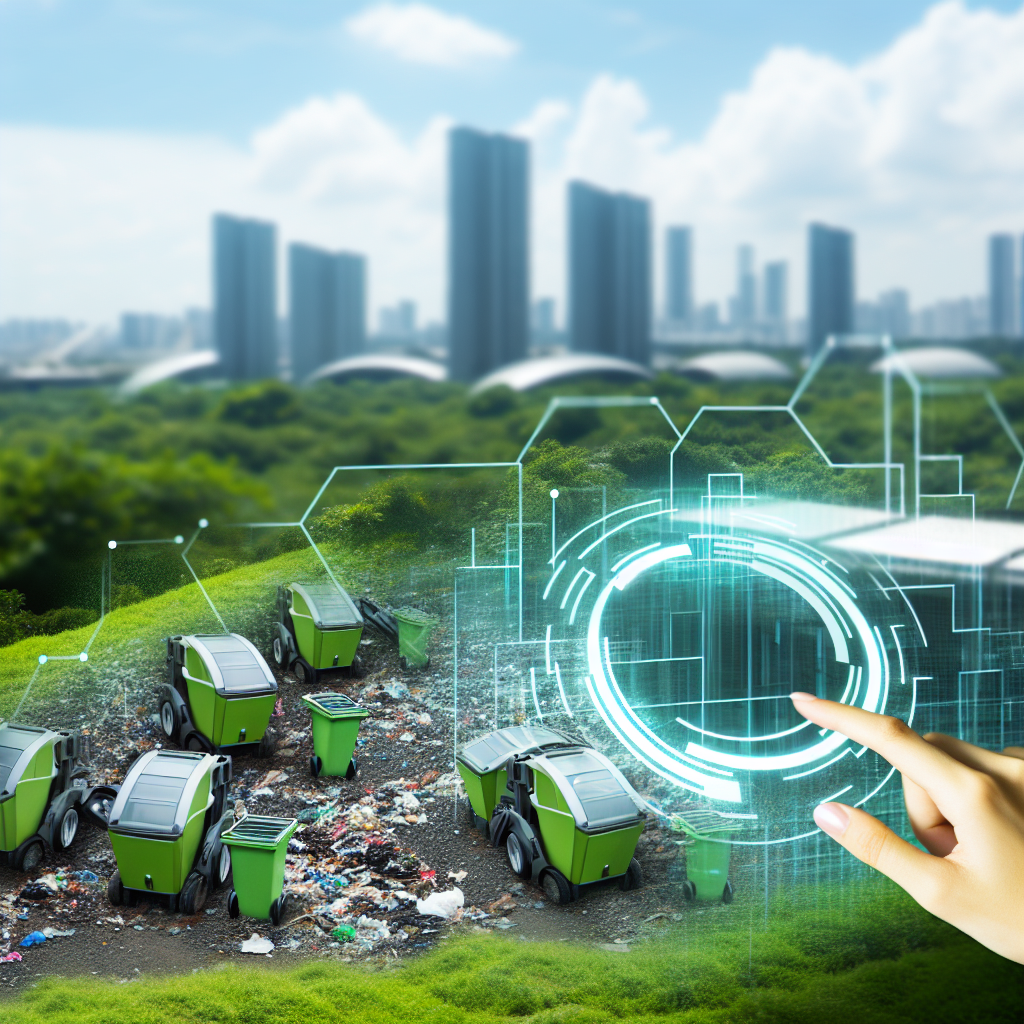Revolutionizing Waste Management: How IoT Waste Solutions Are Transforming Valet Trash Services by 2025
As we approach 2025, the landscape of waste management is undergoing a significant transformation, driven by the integration of Internet of Things (IoT) technologies into valet trash services. This evolution is not only enhancing operational efficiency but also contributing to environmental sustainability. The adoption of IoT solutions in waste management is revolutionizing how valet trash services operate, offering a glimpse into a future where technology and innovation work hand in hand to address the challenges of urban waste disposal.
At the core of this transformation is the implementation of smart sensors and connected devices that provide real-time data on waste levels, collection schedules, and bin usage patterns. These IoT-enabled systems allow valet trash services to optimize their routes and schedules, ensuring that waste is collected only when necessary. This not only reduces the frequency of collections, thereby lowering fuel consumption and emissions, but also minimizes the wear and tear on collection vehicles. Consequently, the integration of IoT technology is leading to more sustainable and cost-effective waste management practices.
Moreover, the data collected from these smart systems is invaluable for waste management companies seeking to improve their services. By analyzing patterns and trends, companies can make informed decisions about resource allocation, staffing, and equipment maintenance. This data-driven approach enables valet trash services to anticipate demand fluctuations and adjust their operations accordingly, ensuring a seamless and efficient service for their clients. Additionally, the ability to monitor waste levels remotely allows for proactive maintenance, reducing the likelihood of overflow and the associated health and environmental risks.
In addition to operational efficiencies, IoT technology is also enhancing customer satisfaction in valet trash services. With the integration of mobile applications and online platforms, residents can now receive notifications about collection schedules, report issues, and provide feedback in real-time. This increased level of communication and transparency fosters a stronger relationship between service providers and their clients, ultimately leading to higher levels of customer satisfaction and retention.
Furthermore, the environmental benefits of IoT waste solutions cannot be overstated. By optimizing collection routes and reducing unnecessary pickups, valet trash services are significantly lowering their carbon footprint. This aligns with the growing demand for sustainable practices in urban living, as cities worldwide strive to reduce their environmental impact. The use of IoT technology in waste management is a critical step towards achieving these sustainability goals, as it promotes more responsible consumption and disposal habits among residents.
As we look towards 2025, it is clear that the integration of IoT technology in valet trash services is not just a trend, but a necessary evolution in waste management. The benefits of these innovations extend beyond operational efficiencies and customer satisfaction, contributing to a more sustainable and environmentally conscious future. As technology continues to advance, it is imperative for waste management companies to embrace these changes and invest in IoT solutions that will drive the industry forward. By doing so, they will not only enhance their service offerings but also play a pivotal role in shaping the future of urban waste management. In conclusion, the revolutionizing impact of IoT waste solutions on valet trash services is a testament to the power of technology and innovation in addressing the complex challenges of modern waste disposal.
Smart Trash and Automated Collection: The Future of Valet Trash Tech and Waste Innovation
As we look toward 2025, the landscape of valet trash services is poised for a significant transformation, driven by technological advancements and innovative strategies. The integration of smart trash systems and automated collection methods is at the forefront of this evolution, promising to enhance efficiency, sustainability, and customer satisfaction. These innovations are not only reshaping how waste is managed but also redefining the role of valet trash services in urban environments.
To begin with, smart trash systems are revolutionizing the way waste is monitored and collected. These systems utilize sensors and Internet of Things (IoT) technology to provide real-time data on waste levels, enabling more efficient collection schedules. By analyzing this data, service providers can optimize routes, reduce fuel consumption, and minimize the environmental impact of waste collection. This data-driven approach ensures that trash is collected only when necessary, thereby reducing unnecessary trips and contributing to a more sustainable operation.
Moreover, the implementation of automated collection methods is set to further streamline valet trash services. Automated systems, such as robotic arms and autonomous vehicles, are being developed to handle the physical collection of waste. These technologies not only reduce the need for manual labor but also enhance safety by minimizing human interaction with potentially hazardous materials. As these systems become more sophisticated, they are expected to handle a wider variety of waste types, including recyclables and organic waste, thus promoting comprehensive waste management solutions.
In addition to improving operational efficiency, these technological advancements are also enhancing customer experience. With the integration of mobile applications and digital platforms, residents can now enjoy greater convenience and transparency in their valet trash services. These platforms allow users to schedule pickups, track service status, and receive notifications, all from the comfort of their smartphones. This level of accessibility and control is increasingly important in today’s fast-paced world, where consumers demand seamless and responsive services.
Furthermore, the adoption of smart trash and automated collection technologies aligns with broader environmental goals. By optimizing waste collection and reducing emissions, these innovations contribute to the reduction of carbon footprints and support sustainable urban development. As cities continue to grow and face mounting waste management challenges, the role of technology in creating efficient and eco-friendly solutions becomes ever more critical.
However, the transition to these advanced systems is not without its challenges. The initial investment in technology and infrastructure can be significant, and service providers must carefully evaluate the cost-benefit ratio. Additionally, there is a need for ongoing maintenance and updates to ensure the reliability and effectiveness of these systems. Despite these hurdles, the long-term benefits of adopting smart trash and automated collection technologies are expected to outweigh the initial costs, offering a compelling case for their implementation.
In conclusion, the future of valet trash services lies in the integration of smart trash systems and automated collection methods. These innovations promise to transform waste management by enhancing efficiency, improving customer experience, and supporting environmental sustainability. As we move toward 2025, it is imperative for service providers to embrace these technologies and develop expert strategies that leverage their full potential. By doing so, they can not only meet the evolving needs of urban communities but also contribute to a cleaner and more sustainable future.
Modern Waste Solutions: Expert Strategies for Implementing Advanced Trash Tech in Valet Services
As urban living continues to evolve, the demand for efficient waste management solutions has become increasingly critical. Valet trash services, once a simple convenience, are now at the forefront of this transformation, driven by technological innovations that promise to redefine the industry by 2025. The integration of advanced technologies into valet trash services not only enhances operational efficiency but also aligns with broader environmental sustainability goals. This article explores expert strategies for implementing cutting-edge trash tech in valet services, offering insights into how these innovations can be effectively harnessed.
To begin with, the adoption of smart waste management systems is a pivotal strategy for modernizing valet trash services. These systems utilize Internet of Things (IoT) technology to monitor waste levels in real-time, enabling service providers to optimize collection schedules and routes. By employing sensors in waste receptacles, valet services can gather data on fill levels, which is then transmitted to a centralized platform. This data-driven approach allows for dynamic route planning, reducing unnecessary trips and minimizing fuel consumption. Consequently, this not only lowers operational costs but also decreases the carbon footprint of waste collection activities.
In addition to IoT, the use of artificial intelligence (AI) and machine learning algorithms is revolutionizing the way valet trash services operate. AI can analyze historical data to predict waste generation patterns, allowing service providers to anticipate peak times and allocate resources accordingly. Machine learning models can also identify inefficiencies in current operations, offering recommendations for process improvements. By leveraging AI, valet trash services can enhance their responsiveness and adaptability, ensuring that waste is collected promptly and efficiently.
Moreover, the integration of mobile applications into valet trash services is another innovative strategy that enhances customer engagement and satisfaction. These apps provide residents with real-time updates on collection schedules, notifications for service delays, and the ability to request additional pickups. Furthermore, mobile platforms can facilitate seamless communication between residents and service providers, allowing for quick resolution of issues and feedback collection. By prioritizing user experience, valet trash services can build stronger relationships with their clients and foster a sense of community involvement in waste management efforts.
Another critical aspect of implementing advanced trash tech in valet services is the emphasis on sustainability. The use of eco-friendly vehicles, such as electric or hybrid trucks, for waste collection is gaining traction as a means to reduce emissions. Additionally, valet services are increasingly exploring partnerships with recycling facilities to ensure that collected waste is processed responsibly. By incorporating sustainable practices into their operations, valet trash services can contribute to broader environmental conservation efforts while meeting the growing demand for green solutions.
Finally, the success of these technological innovations hinges on effective training and development programs for staff. As new systems and tools are introduced, it is essential for employees to be well-versed in their operation and maintenance. Comprehensive training programs that focus on both technical skills and customer service can empower staff to deliver high-quality service while adapting to technological advancements. By investing in workforce development, valet trash services can ensure a smooth transition to modern waste management practices.
In conclusion, the future of valet trash services lies in the strategic implementation of advanced technologies that enhance efficiency, sustainability, and customer satisfaction. By embracing IoT, AI, mobile applications, and eco-friendly practices, service providers can position themselves at the forefront of the industry, ready to meet the challenges and opportunities of 2025. As these innovations continue to evolve, they hold the promise of transforming valet trash services into a model of modern waste management excellence.
Discover the future of waste management with cutting-edge technology and innovative strategies in valet trash services. Stay ahead in 2025 by exploring expert insights and solutions. Learn more now!



